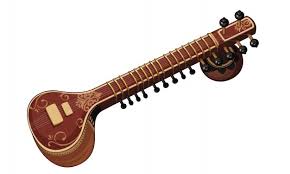Search Topic
Veena the classical Indian Instrument
Veena the classical instrument

Veena the classical instrument is auspicious in Indian religious context which imagined to be as an instrument of the Goddess Saraswati. One of the oldest of Indian musical instruments. It belongs to a family of chordophone instruments. This is a type of plucked string musical instrument. From descriptions in the vedic literature tend to suggest veena of a different design than the present day ones. In the Indian music has always kept the highest regard for the veena music. Any type Indian raga music can be played on it. It can create beautiful and complex melody instrument in other music genres or it may be played for meditative purposes to sooth the nerves, to enhance the mental health.
Types of Veena
Veena the classical instrument, basically classified into three major families
-
Rudra Veena
Is a type of fretted instrument with hollow neck with two equal size resonators (called tumba) below the neck. This instrument is played by laying it slanting with one gourd on a knee and other above the shoulder. The resonators also connected with a fret board with 24 frets.
-
Saraswati Veena
It’s another fretted instrument, with one resonator & a small resonator connected with a fret board with 24 frets. It is has a pear-shaped, hollow resonator made of wood, connected to the end of the neck and the bridge. It’s resonator is carved out of a single piece of solid wood, its neck is narrower (so that its strings can not be pulled quite as far sideways as on the sitar), the frets are flat and fitted into a bed of wax, the bridge has a metal surface and it has no sympathetic strings. It’s most widely-played version of this instrument. It also known as Tanjore Veena. It is is used most often in South Indian Carnatic music.
-
Vichitra Veena
It do not have frets. It’s is played with a slide. It’s having five drone strings and 13 sympathetic strings. The vichitra veena is most often used in North Indian Hindustani music.
Parts of a Veena
The difference lies in the shape and construction of the resonator, or soundbox. The difference between the North and South Indian design is the presence of two resonant gourds in the North, but in the South a pear-shaped wooden body attached. The hollow body of the instrument is made from wood with two resonators at each end on the back of the instrument. Melody is produced on four metal strings that run above the frets. These are stretched over a wide bridge that sits on the body of the veena. Three other strings run alongside the neck of the instrument. These are used for maintaining time and for playing the drone.
Conclusion:
Veena is an Indian musical instrument, which is played by the strings. It is one of the most popular instruments of India. The history of veena can be traced back to the ancient time’s Vedic period. In this article, we have provided you with some interesting facts about Veena that should make playing the instrument easier. We hope you enjoy learning more about this unique musical tool!








